1 Introduction to Oracle Retail Xstore POS
The Oracle Retail Xstore Suite has always offered a highly flexible deployment model that includes Xstore Classic, Desktop, Thin Client, Tablet, and Handheld options at the store. Oracle Retail Xstore Point of Service is a point-of-sale application that provides the capabilities to carry out day-to-day transactions and conduct daily store activities. Tasks such as scanning items, applying price adjustments, tendering, and printing receipts as well as processing returns, and web orders can be performed. Store operations including opening the store, managing registers and tills, and closing the store can be handled through Oracle Retail Xstore Point of Service (POS).
Xstore POS is built utilizing the existing Xstore core frameworks and work flows to ensure a consistent experience for the associate. Xstore Desktop and Thin Client are available on both Windows and Linux. Tablet and Handheld are supported on iOS, Android and Windows.
A list of Xstore POS supported devices and operating systems can be found in the Oracle Retail Xstore Suite Implementation and Security Guide.
Note:
The appearance of Xstore POS differs depending upon the operating system and the specific device on which it runs. Therefore, your screens may differ from the screens that appear in this guide.
All menus are configurable and may appear different based on your store's settings.
This chapter covers the following topics:
About this Guide
The Oracle Retail Xstore Point of Service User Guide describes how to perform the functions available in Desktop, Handheld, Thin Client, and Tablet devices. For a complete list of functionality available on each device type see Feature Availability.
This guide is broadly separated into two halves: the first half covering the functions of the point of service such as sale transactions, item and transaction modifiers, such as discounts and price overrides, multiple tender types, item lookup, gift card sales, and inquiry and serialized item support, and the second half covering the point of service maintenance functions. These functions are usually performed outside of a sale. Store employees can perform non-customer facing activities within the store such as start and end day, banking, associate role and security maintenance, time and attendance maintenance along with analytical reporting.
Where to Look for Additional Help
A variety of guides provide you with complete information about the Oracle Retail Xstore Point of Service system.
-
The Oracle Retail Xstore Jet Configuration Reference Paper available on My Oracle Support.
As with previous versions of Xstore, the client applications responsible for rendering the user interface are not directly modifiable. That being said, the reimagined Xstore user experience continues to follow the pattern of respecting configuration changes made to the Xstore server via the extension layer, and such changes will be reflected in the Xstore UI. This document provides details about changes to these configurations and how to go about customizing and styling Xstore.
-
The Oracle Retail Xstore Point of Service Classic User Guide provides detailed information for Xstore Classic for entering sale, refund, and miscellaneous transactions, and is designed to provide training assistance for cashier-level employees. It also provides detailed basic navigation information such as touch-screen components.
-
The Oracle Retail Xstore Point of Service Classic Shipping, Receiving, & Inventory Guide provides step-by-step instructions for shipping and receiving functions, as well as the procedures required for counting and managing inventory through Oracle Retail Xstore Point of Service.
-
The Oracle Retail Xstore Point of Service Reports Guide contains a description of each report, step-by-step instructions on how to run each report, an explanation of the criteria selection options, and a report sample.
-
The Oracle Retail Xstore Point of Service User Guide describes how to perform the functions available on Desktop, Thin Client, Tablet, and Handheld devices.
-
A list of Xstore POS supported devices and operating systems can be found in the Oracle Retail Xstore Suite Implementation and Security Guide.
Desktop and Tablet Overview
An example of the home screen on a tablet is shown below:
Figure 1-1 Desktop Home Screen
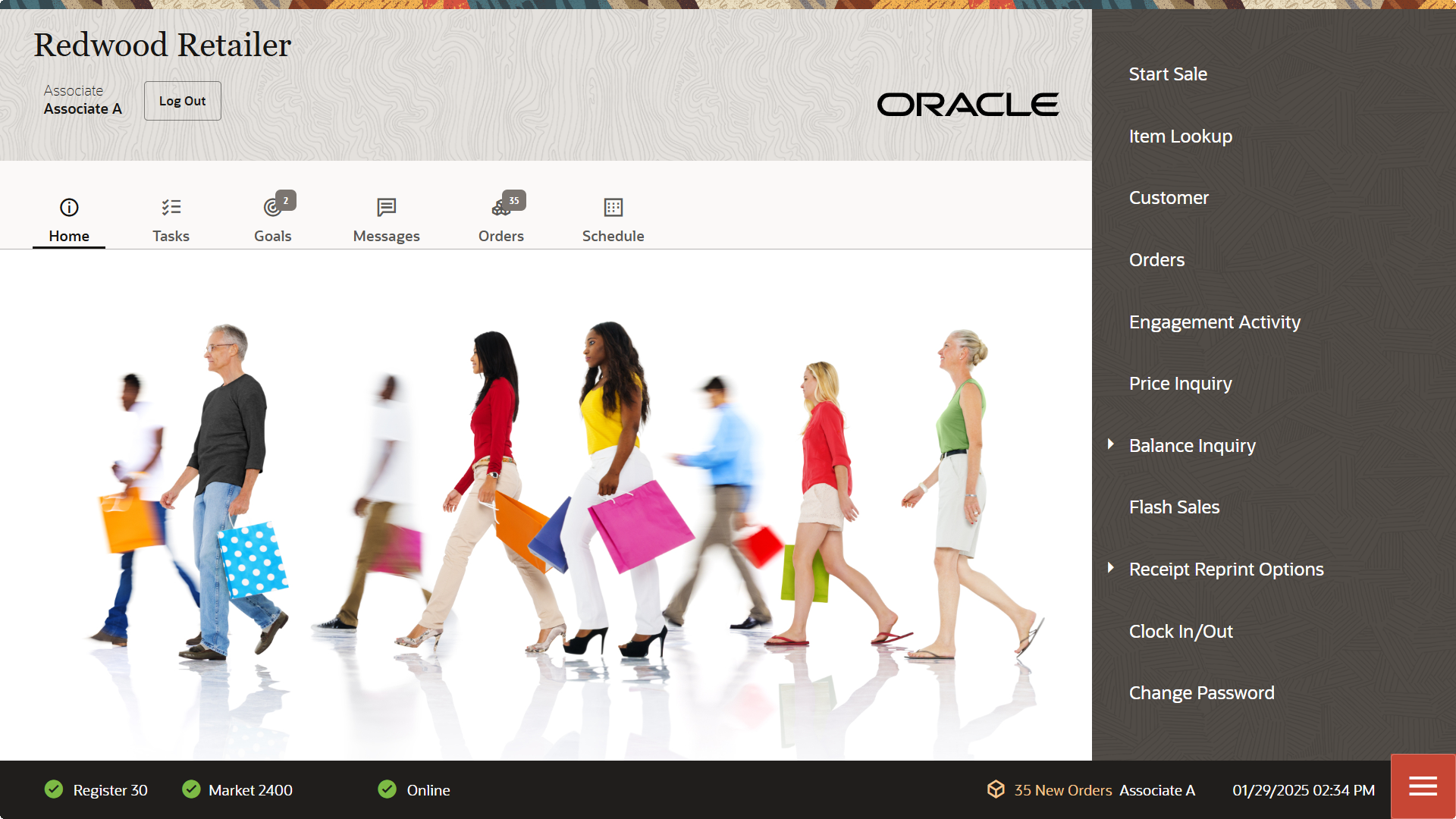
Figure 1-2 Tablet Home Screen
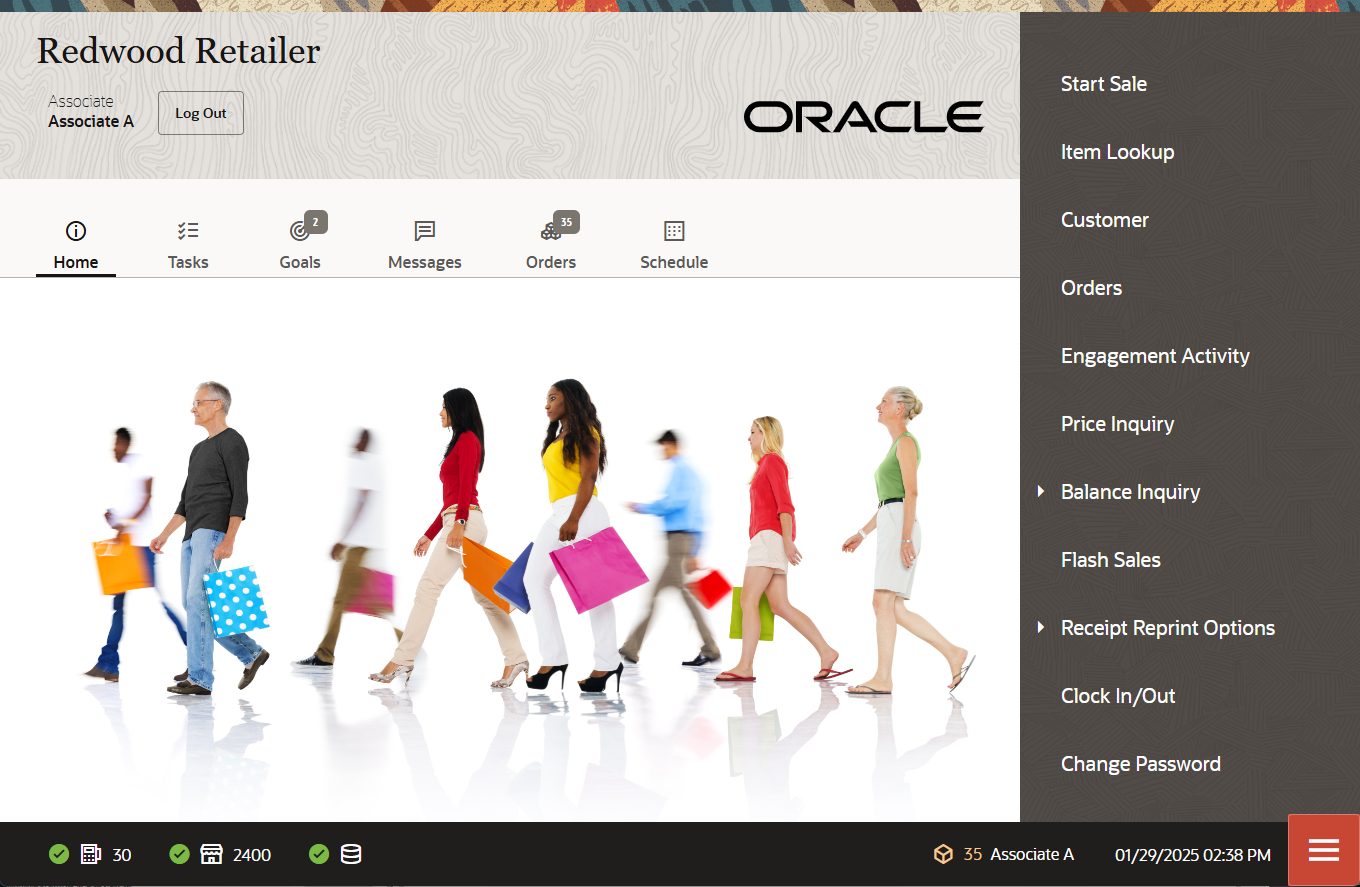
The Login button at the top of the screen allows the user to enter an associate ID and subsequently, a password. When configured, the user can scan a badge to login instead of entering an associate ID.
The Tabs below the Login area. It uses icon indicators for each of the tabs. Different tabs are displayed based on login status and privileges. The numbers next to the icons display the count.
The Status Bar at the bottom is a screen component that displays several items of store-related information. It shows the register status (green when open/red when closed), store number, associate when logged in/blank when no associate logged in, data source status, order count, and the business date and time.
The Global Navigation and Home Screen Menus provide a starting point for the user. The Home Screen menu is available on the right hand side, and in the lower-right hand corner of the screen is the Global Navigation Menu.
The menus are driven by security privileges, and whether the user is logged in or out.
The Xstore User Interface has been optimized for larger screen tablets. Smaller tablet devices will have an adjusted visual experience to account for the screen size. To handle this one of the panels on larger screens will be hidden behind a button or menu option. An example of this is the transaction screen. The customer panel can be viewed by selecting the customer icon button and the drawer will open from the left side. On a larger screen device, that panel is visible on the transaction screen. The Store, Register, Datasource, Transaction and Orders will also automatically update to icons from verbiage as well on smaller screens.
The Home Screen menu has the following options:
Select the respective option to access the appropriate functionality.
Select the respective option to navigate to the appropriate functionality or click the Global Navigation Menu and start typing in the search bar and select the function required. See Search Menu Option.
See Feature Availability for more information regarding functionality available on the Xstore POS devices.
Table 1-1 Home Screen Menu
| Main Menu Option | Description |
|---|---|
|
Start Sale |
This option provides access to all aspects of a POS transaction from associating customers, adding items, changing quantities, adding discounts, processing tenders, and providing receipts. |
|
Item Lookup |
Use the Item Lookup option to search for an item in the database. |
|
Customer |
Includes activities that relate to entering new customers into the customer database and updating customer information. Also covers extended transaction maintenance such as Layaway, Local Orders, Special Orders, Work Orders, and Send Sale Shipping. |
|
Orders |
After Order Broker is configured for your store, use the Order options to maintain the order. A store can only see orders initiated in the store and orders downloaded to the store for sourcing or pick up. |
|
Engagement Activity |
Requires integration with Oracle Retail Customer Engagement. Mainly for fashion retailers to track and capture activities pre transaction such as which items are tried on and the changing room used. From here you can convert to a sale or save to the wish list (items that a customer has expressed an interest in). |
|
Balance Inquiry |
Use the balance inquiry process to check the amount remaining on a customer's store credit voucher, gift card or gift certificate, and an item's price from a gift receipt. |
|
Flash Sales |
The Flash Sales reports provide an instant snapshot of sales at the moment that you select one of the reports. Three of the four reports display data in a column format and in graphic format as bar charts and pie charts. The exception is the Flash Sales By Associate Report, which does not include graphs. |
|
Receipt Reprint Options |
The reprint options provide a way to recover when there is a printer error or the printer jams. They allow you to reprint a receipt or a rebate offer for the customer |
|
Clock In/Out |
Depending upon your store policy, you may be required to clock in before logging in. |
|
Change Password |
User can change their password. |
|
Enter Training Mode |
Activates the Training Mode. |
Figure 1-3 Desktop Sales Screen

Figure 1-4 Tablet Sales Screen

The Sales screen is where transactions are performed. For basic transactions, simply enter an item ID, or select the barcode icon and scan items using the device camera. In the viewport, you will see the item, the price, the quantity, and the extended price. Note, we have the taxes, the fees, if applicable, and the subtotal. We also have a running items list count. When ready to tender, select the amount due to show a list of tenders and continue payment to complete the transaction. For other transactions such as special orders, or to sell non-merchandize gift cards, or to add a discount, select the Global Navigation Menu in the lower-right hand corner of the screen.
The device also provides all functions for maintaining the POS operations. You can manage the store and registers such as opening and closing, and reconciliation, set up customers, schedule hours for employees, perform inventory tasks and view and print reports. See Maintenance Functions for more information.
Handheld Overview
An example of the home screen on a handheld is shown below.
Figure 1-5 Handheld Home Screen - Logged Out and Register Closed
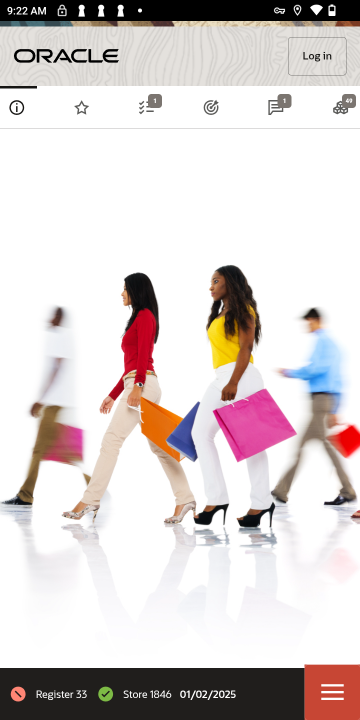
Figure 1-6 Handheld Home Screen - Logged In and Register Open
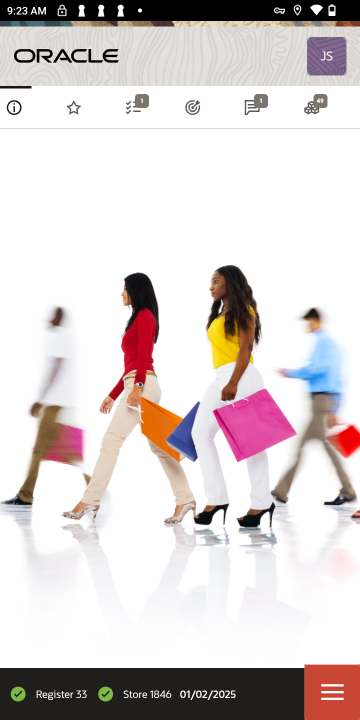
Global Navigation is located in the lower-right hand corner of the screen.
The Login area at the top of the screen allows you to enter your associate ID and subsequently, your password. When configured, you can scan your badge to login instead of entering your associate ID.
The tabs below the Login area are available. The tab with the star icon, called the Shortcut Menu, is a list of actions the associate can quickly select. The other tabs can be selected and viewed as needed by the associate.
The Status Bar at the bottom is a screen component that displays several items of store related information. It shows the following:
-
Register Status (Greenwhen open / Red
 when closed)
when closed)
-
Store Number
-
Business Date
Global Navigation Menu
Figure 1-7 Global Navigation Menu

The handheld application users tabs. That are used by screens to easily navigate between screen options. Below is an example of the use of these tabs.
Figure 1-8 Shopping Cart Tabs

Figure 1-9 Handheld Transaction View

Thin Client Overview
Xstore POS can be installed as a thin client on a workstation.
A list of Xstore POS supported devices and operating systems can be found in the Oracle Retail Xstore Suite Implementation and Security Guide.
Thin client communicates with the mobile server just like Tablet and Handheld. It has the same technical architecture as the tablet and handheld. There is no local database.
Feature Availability
The table below shows the functionality available on each device type. Some functionality is not available on the handheld due to screen size restraints. Blank fields indicate the feature is not available on that device. A 'P' means partial functionality is available for that device.
Table 1-2 Feature Availability by Device
| Main Category | Feature | Xstore Classic | Desktop | Thin Client | Tablet | Handheld |
|---|---|---|---|---|---|---|
|
Associate |
Change Password |
✓ |
✓ |
✓ |
✓ |
✓ |
|
Associate |
Clock In/Out |
✓ |
✓ |
✓ |
✓ |
✓ |
|
Associate |
Task Mgmt. - create, view, update, my tasks |
✓ |
✓ |
✓ |
✓ |
P |
|
Associate |
Training Mode |
✓ |
✓ |
✓ |
✓ |
✓ |
|
Associate |
User Guide |
✓ |
✓ |
✓ |
✓ |
✕ |
|
Associate |
View Schedule & Time |
✓ |
✓ |
✓ |
✓ |
✕ |
|
Customer |
Add new Customer |
✓ |
✓ |
✓ |
✓ |
✓ |
|
Customer |
Assign/View/Edit Customer |
✓ |
✓ |
✓ |
✓ |
✓ |
|
Customer |
Balance Inquiry |
✓ |
✓ |
✓ |
✓ |
✓ |
|
Customer |
Customer Maintenance / Dashboard |
✓ |
✓ |
✓ |
✓ |
✓ |
|
Customer |
Enroll in Loyalty |
✓ |
✓ |
✓ |
✓ |
✓ |
|
Customer |
Gift Card Balance Inquiry |
✓ |
✓ |
✓ |
✓ |
✓ |
|
Customer |
House Account Set Up |
✓ |
✓ |
✓ |
✓ |
✓ |
|
Customer |
Receipt Reprint Options |
✓ |
✓ |
✓ |
✓ |
✓ |
|
Customer |
Tax Exemptions |
✓ |
✓ |
✓ |
✓ |
✓ |
|
Customer |
Wish List |
✓ |
✓ |
✓ |
✓ |
✓ |
|
Associate |
Associate Advance |
✓ |
✓ |
✓ |
✓ |
✕ |
|
Associate |
Associate Borrow |
✓ |
✓ |
✓ |
✓ |
✕ |
|
Associate |
Associate Maintenance / Dashboard |
✓ |
✓ |
✓ |
✓ |
✕ |
|
Associate |
Associate Schedule |
✓ |
✓ |
✓ |
✓ |
✕ |
|
Associate |
Maintain Associate Time Off |
✓ |
✓ |
✓ |
✓ |
✕ |
|
Associate |
Message Maintenance - create, edit, delete |
✓ |
✓ |
✓ |
✓ |
P |
|
Associate |
Payroll & Timecard Maintenance |
✓ |
✓ |
✓ |
✓ |
✕ |
|
Associate |
Shift Maintenance |
✓ |
✓ |
✓ |
✓ |
✕ |
|
Global |
Country Packs |
✓ |
✓ |
✓ |
✓ |
✓ |
|
Global |
Tax Free Invoices - Issue, Reprint, Void, Returns |
✓ |
✓ |
✓ |
✓ |
✓ |
|
Inventory |
Inventory Replenishment |
✓ |
✓ |
✓ |
✓ |
✓ |
|
Inventory |
Location Based Inventory |
✓ |
✓ |
✓ |
✓ |
✓ |
|
Inventory |
Physical, Cycle, Supply Counts |
✓ |
✓ |
✓ |
✓ |
✓ |
|
Inventory |
Receiving |
✓ |
✓ |
✓ |
✓ |
✓ |
|
Inventory |
Shipping |
✓ |
✓ |
✓ |
✓ |
✓ |
|
Orders |
Message Alerts - for Orders |
✓ |
✓ |
✓ |
✓ |
P |
|
Orders |
Order Maintenance |
✓ |
✓ |
✓ |
✓ |
✓ |
|
Orders |
Orders Tab |
✓ |
✓ |
✓ |
✓ |
✓ |
|
Reports |
Reports |
✓ |
✓ |
✓ |
✓ |
✓ |
|
Sale |
Add All Discount Types |
✓ |
✓ |
✓ |
✓ |
✓ |
|
Sale |
Add Coupon |
✓ |
✓ |
✓ |
✓ |
✓ |
|
Sale |
Add Line Item Comment |
✓ |
✓ |
✓ |
✓ |
✓ |
|
Sale |
Airside Functionality |
✓ |
✓ |
✓ |
✓ |
✓ |
|
Sale |
Assign to a Gift Registry |
✓ |
✓ |
✓ |
✓ |
✓ |
|
Sale |
Black Book |
✓ |
✓ |
✓ |
✓ |
✓ |
|
Sale |
Cancel Sale |
✓ |
✓ |
✓ |
✓ |
✓ |
|
Sale |
Change Item |
✓ |
✓ |
✓ |
✓ |
✓ |
|
Sale |
Change Kit Serial Number |
✓ |
✓ |
✓ |
✓ |
✓ |
|
Sale |
Change Sale Associate |
✓ |
✓ |
✓ |
✓ |
✓ |
|
Sale |
Change Tax details |
✓ |
✓ |
✓ |
✓ |
✓ |
|
Sale |
Gift Receipt |
✓ |
✓ |
✓ |
✓ |
✓ |
|
Sale |
Gift Registry Setup |
✓ |
✓ |
✓ |
✓ |
✕ |
|
Sale |
Hold |
✓ |
✓ |
✓ |
✓ |
✓ |
|
Sale |
House Account |
✓ |
✓ |
✓ |
✓ |
✓ |
|
Sale |
Inventory Locator |
✓ |
✓ |
✓ |
✓ |
✓ |
|
Sale |
Item Lookup |
✓ |
✓ |
✓ |
✓ |
✓ |
|
Sale |
Layaway |
✓ |
✓ |
✓ |
✓ |
✓ |
|
Sale |
Layaway Maintenance |
✓ |
✓ |
✓ |
✓ |
✕ |
|
Sale |
Lock Register |
✓ |
✓ |
✓ |
✓ |
✓ |
|
Sale |
Modify Discount |
✓ |
✓ |
✓ |
✓ |
✓ |
|
Sale |
No Sale |
✓ |
✓ |
✓ |
✓ |
✓ |
|
Sale |
Orders |
✓ |
✓ |
✓ |
✓ |
✓ |
|
Sale |
Post Void |
✓ |
✓ |
✓ |
✓ |
✓ |
|
Sale |
Pre-Sale |
✓ |
✓ |
✓ |
✓ |
✓ |
|
Sale |
Price Inquiry |
✓ |
✓ |
✓ |
✓ |
✓ |
|
Sale |
Product Information / Item Dashboard |
✓ |
✓ |
✓ |
✓ |
P |
|
Sale |
Rain Check |
✓ |
✓ |
✓ |
✓ |
✓ |
|
Sale |
Return Item |
✓ |
✓ |
✓ |
✓ |
✓ |
|
Sale |
Sell Non-Merchandise |
✓ |
✓ |
✓ |
✓ |
✓ |
|
Sale |
Send Sales |
✓ |
✓ |
✓ |
✓ |
✓ |
|
Sale |
Special Order |
✓ |
✓ |
✓ |
✓ |
✓ |
|
Sale |
Special Order Maintenance |
✓ |
✓ |
✓ |
✓ |
✕ |
|
Sale |
Store Open Close Indicator |
✓ |
✓ |
✓ |
✓ |
✓ |
|
Sale |
Suspend/Resume Transaction |
✓ |
✓ |
✓ |
✓ |
✓ |
|
Sale |
Tab Features |
✓ |
✓ |
✓ |
✓ |
✓ |
|
Sale |
Tender with all Tender Types |
✓ |
✓ |
✓ |
✓ |
✓ |
|
Sale |
Void Line |
✓ |
✓ |
✓ |
✓ |
✓ |
|
Sale |
Warranty |
✓ |
✓ |
✓ |
✓ |
✓ |
|
Sale |
Work Order |
✓ |
✓ |
✓ |
✓ |
✓ |
|
Store Safe |
Open Store Safe |
✓ |
✓ |
✓ |
✓ |
✕ |
|
Store Safe |
Bank Deposit |
✓ |
✓ |
✓ |
✓ |
✓ |
|
Store Safe |
Safe Bag |
✓ |
✓ |
✓ |
✓ |
✓ |
|
Store Safe |
Store Safe Audit |
✓ |
✓ |
✓ |
✓ |
✓ |
|
Store Safe |
Store Safe Cash Deposit |
✓ |
✓ |
✓ |
✓ |
✓ |
|
System Admin |
Datasource Status |
✓ |
✓ |
✓ |
✓ |
✓ |
|
System Admin |
EFTLink Admin Functions |
✓ |
✓ |
✓ |
✓ |
✓ |
|
System Admin |
Enable/Disable Hardware |
✓ |
✓ |
✓ |
✓ |
✕ |
|
System Admin |
Manage Networked Cash Drawers |
✓ |
✓ |
✓ |
✓ |
✕ |
|
System Admin |
Mobile Device Access |
✓ |
✓ |
✓ |
✓ |
✓ |
|
System Admin |
Mobile Device Users |
✓ |
✓ |
✓ |
✓ |
✓ |
|
System Admin |
Mobile Device Quick Configuration |
✓ |
✓ |
✓ |
✓ |
✓ |
|
System Admin |
Offline Sales Transactions |
✕ |
✕ |
✕ |
✓ |
✓ |
|
System Admin |
Offline Transaction Review |
✕ |
✓ |
✕ |
✓ |
✕ |
|
System Admin |
Print Offline Transaction Receipt |
✕ |
✓ |
✓ |
✓ |
✓ |
|
System Admin |
Reinitialize Hardware |
✓ |
✓ |
✓ |
✓ |
✓ |
|
System Admin |
Temporary Store |
P1 |
✓ |
✓ |
✓ |
✓ |
|
Till |
Attach/Remove Other Till or Cash Drawer Till |
✓ |
✓ |
✓ |
✓ |
✓ |
|
Till |
Attach/Remove Till or Cash Drawer Till |
✓ |
✓ |
✓ |
✓ |
✓ |
|
Till |
Cash Pickup |
✓ |
✓ |
✓ |
✓ |
✓ |
|
Till |
Cash Transfer |
✓ |
✓ |
✓ |
✓ |
✓ |
|
Till |
Change Float |
✓ |
✓ |
✓ |
✓ |
✓ |
|
Till |
Count Till |
✓ |
✓ |
✓ |
✓ |
✕ |
|
Till |
End Count Other Till |
✓ |
✓ |
✓ |
✓ |
✕ |
|
Till |
Foreign Currency Maintenance |
✓ |
✓ |
✓ |
✓ |
✓ |
|
Till |
Issue/Return Till |
✓ |
✓ |
✓ |
✓ |
✕ |
|
Till |
Mid-day Deposit |
✓ |
✓ |
✓ |
✓ |
✓ |
|
Till |
Open/Close Networked Cash Drawer |
✓ |
✓ |
✓ |
✓ |
✓ |
|
Till |
Paid In / Paid Out |
✓ |
✓ |
✓ |
✓ |
✓ |
|
Till |
Print Till Summary Receipt |
✓ |
✓ |
✓ |
✓ |
✓ |
|
Till |
Register Accountability |
✓ |
✓ |
✓ |
✓ |
✓ |
|
Till |
Remove Other Till - Till Mode |
✓ |
✓ |
✓ |
✓ |
✕ |
|
Till |
Remove Till - Till Accountability Mode |
✓ |
✓ |
✓ |
✓ |
✕ |
|
Till |
Tender Exchange |
✓ |
✓ |
✓ |
✓ |
✓ |
|
Till |
Till Accountability |
✓ |
✓ |
✓ |
✓ |
✓ |
|
Till |
Till Audit |
✓ |
✓ |
✓ |
✓ |
✓ |
|
Till |
Till Counts |
✓ |
✓ |
✓ |
✓ |
✓ |
|
Till |
24 Hour Trading |
✓ |
✓ |
✓ |
✓ |
✓ |
|
Work Order |
Work Order Maintenance |
✓ |
✓ |
✓ |
✓ |
✓ |
P - Partial exposure of functionality on handheld due to the size of the form factor.
P1 - Partial exposure of temporary store functionality on desktop that is, you can only request a temporary store server, and generate QR codes from a desktop. You cannot set up temporary store registers.
Login
No transactions or maintenance can be performed until you log in at the Home screen. This prevents unauthorized personnel from accessing the device/register. Logging in also allows the system to record each associate's sales, calculate commissions, and compare sales to associate goals.
Depending upon your system's configuration, you may be required to clock in before logging in. For more information about the clock-in procedure, refer to Clock In/Out.
The following example shows logging on to a Tablet, but the procedure is the same for other devices such as the Desktop, Thin Client and Handheld. If your Desktop or Thin Client system is set up to use a Biometric Fingerprint device, use the device to scan your fingerprint rather than entering your user ID and password.
To log in to a Xstore POS device:
Figure 1-10 Login

-
Select Login.
-
Enter your Associate ID.
Figure 1-11 Security Window

-
Enter your Password
Note:
Optional: Select the Eye icon to unmask the password to confirm. -
Select Login to Log into the system, or Cancel to return to the Home Screen.
Clock In/Out
Depending upon your store policy, you may be required to clock in before logging in. You may also be required to clock in and out for meal breaks. If meal break clock-out and clock-in is enforced, you cannot clock back in after a meal break until a specified period has elapsed.
The time clock area in Xstore POS provides users with the ability to clock in, clock out, and change the work code used for logging their time. All time clock options are accessed through the Clock In/Out menu option on the Home screen.
Figure 1-12 Home Screen Menu

The following procedures are covered:
-
Clock In - Describes how to clock in.
-
Clock Out - Describes how to clock out.
-
Change Work Code - Describes how to change the work code under which your time is to be logged.
Clock In
Note:
You must be clocked out to clock in.
For your timecard to accurately reflect the number of hours worked, you must clock in and out by performing the following steps.
To clock in:
-
Select Clock In/Out from the Home Screen Menu. See Figure 1-12.
Figure 1-13 Clock In Login Screen
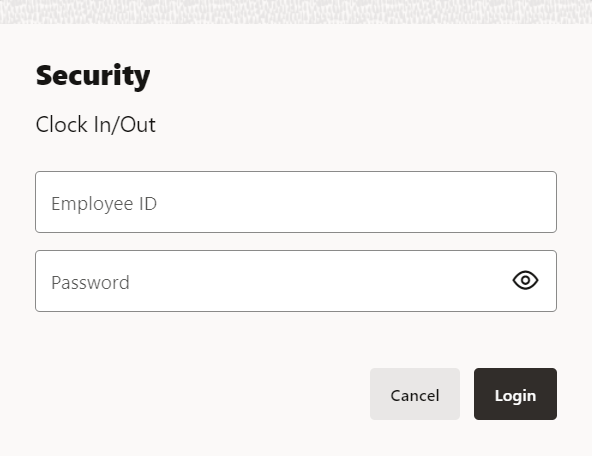
-
Enter your Associate ID and Password.
-
Select Login.
Figure 1-14 Select Work Code
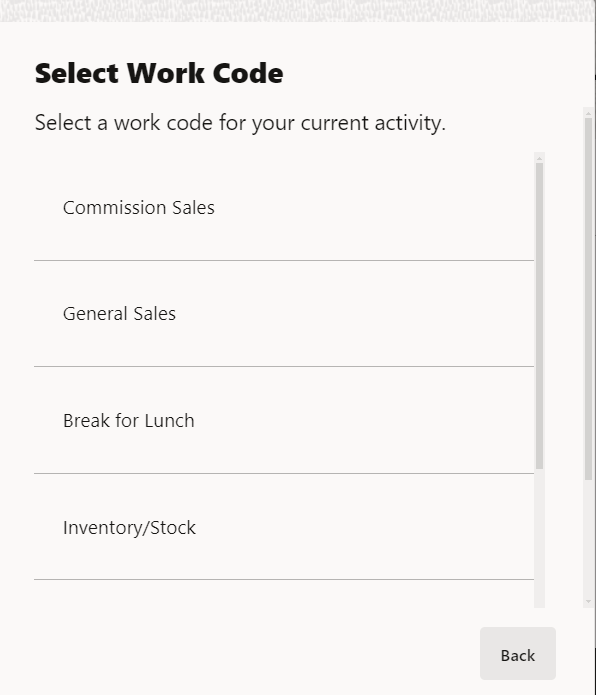
-
Select the proper work code.
You are now clocked in. Xstore POS returns to the Home screen.
Clock Out
Note:
You must be clocked in to clock out.
To clock out:
-
Select Clock In/Out from the Home Menu screen. See Figure 1-12.
Figure 1-15 Login Screen

-
Enter your Associate ID and Password.
-
Select Process.
Figure 1-16 Tablet Change Work Code or Clock Out

-
Select Clock Out.
You are now clocked out. Xstore POS returns to the Home screen.
Change Work Code
Note:
You must be clocked in to change your work code.
To change your work code:
-
Select Clock In/Out from the Menu in the Home screen. See Figure 1-12.
Figure 1-17 Login Screen

-
Enter Associate ID and Password.
-
Select Login.
Figure 1-18 Tablet Change Work Code or Clock Out

Figure 1-19 Change Work Code
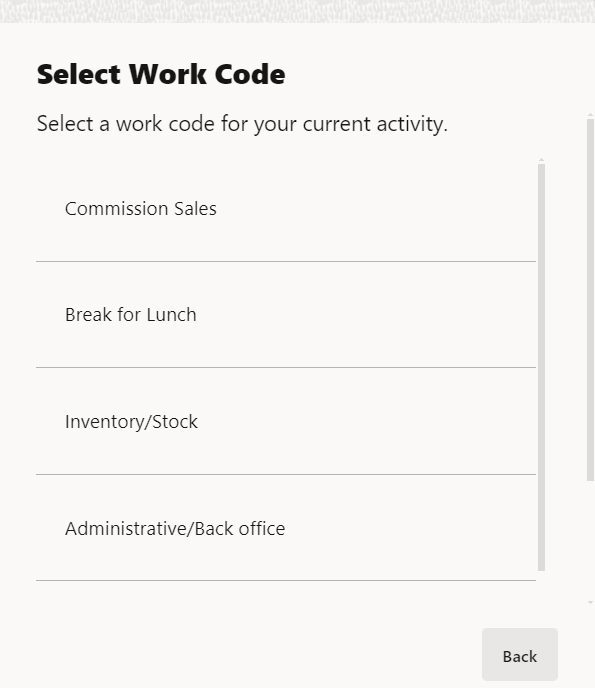
-
Select Change Work Code.
Figure 1-20 Tablet Select Work Code

-
Select the proper work code.
Your work code has been changed. Xstore POS returns to the Home screen.